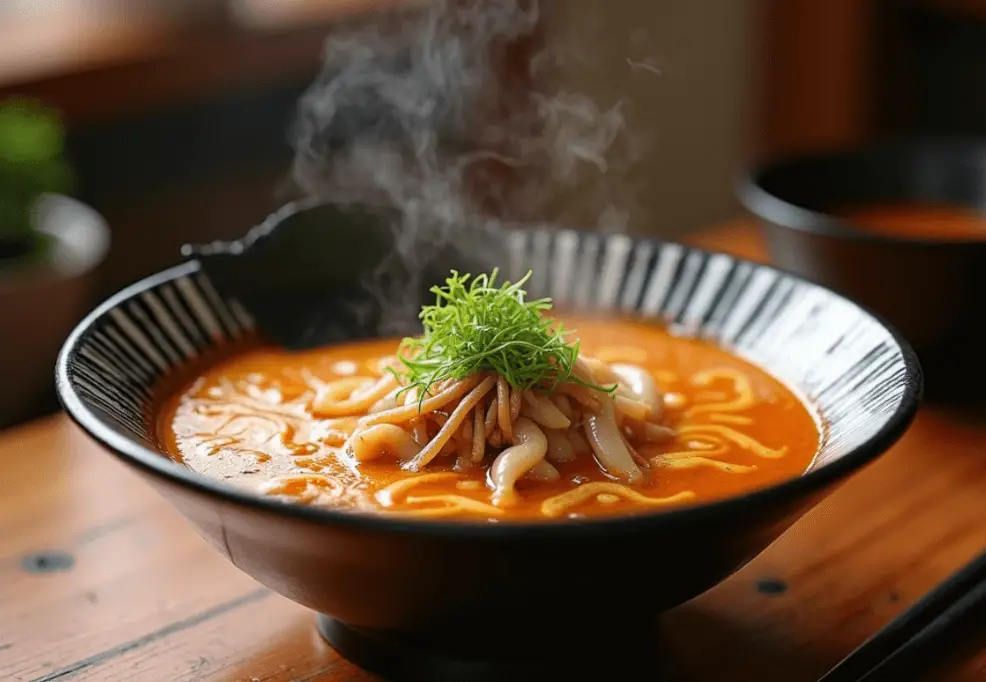Onomichi Dango Masayoshi Ramen is a beloved culinary treasure from the charming coastal city of Onomichi, nestled along the Seto Inland Sea in Japan.
This unique dish perfectly blends traditional Japanese ramen with an innovative twist – the addition of dango (rice dumplings), creating a one-of-a-kind dining experience.
The star of the show is its distinctive soy-based broth, carefully simmered with local seafood like skipjack tuna and bonito, which gives it a rich, complex flavor that sets it apart from typical ramen varieties.
The noodles are specially crafted using a mix of rice and wheat flour, making them thicker and chewier than standard ramen noodles.
What makes this dish truly special is its perfect balance of savory and sweet notes, achieved through the careful combination of traditional ramen elements with dango-inspired components.
The dish represents more than just a meal – it’s a symbol of Onomichi’s culinary heritage and innovative spirit, drawing both locals and tourists to experience its unique flavors.
Each bowl is thoughtfully garnished with classic toppings like braised pork, bamboo shoots, and fresh green onions, creating a harmonious blend of textures and tastes that tell the story of this coastal town’s rich food culture.
Historical Background of Onomichi dango masayoshi ramen original
The story of Onomichi Dango Masayoshi Ramen began in post-war Japan, emerging from the charming coastal town of Onomichi in Hiroshima Prefecture. The dish’s creation is credited to Chef Masayoshi, who revolutionized the local ramen scene by introducing a unique fusion concept.
The evolution of this distinctive dish reflects Onomichi’s rich maritime heritage. The original recipe combined a soy-based broth with locally-sourced ingredients from the Seto Inland Sea, including skipjack tuna and bonito, creating a depth of flavor unique to the region.
Chef Masayoshi’s innovative twist came with the addition of dango (rice dumplings) to traditional ramen, marking a bold departure from conventional recipes.
The cultural significance of Onomichi Dango Masayoshi Ramen extends beyond its culinary appeal. In Onomichi, ramen isn’t just a meal – it’s a symbol of community and tradition.
The dish represents the perfect balance between preserving cultural heritage and embracing innovation. Local ramen shops became gathering spots where both residents and tourists connect over steaming bowls of this unique creation.
The recipe’s evolution continued as it gained popularity, with each element carefully refined. The noodles became thicker than traditional ramen, specifically designed to complement the rich broth.
The addition of seasonal toppings and local ingredients further cemented its status as a regional specialty. Today, Onomichi Dango Masayoshi Ramen stands as a testament to Japanese culinary innovation, drawing food enthusiasts from across the globe to experience its unique blend of flavors.
Key Components of Onomichi dango masayoshi ramen original
The Signature Broth
The heart of Onomichi Dango Masayoshi Ramen lies in its distinctive broth. The base combines pork bones and chicken bones, simmered with dried sardines and bonito flakes for several hours.
This foundation is enhanced with kombu (sea kelp) and shiitake mushrooms, creating a deep umami flavor. The preparation method requires careful temperature control during a long simmering process, often lasting 6-8 hours, to extract maximum flavor.
The broth’s unique characteristics come from its soy-based profile balanced with subtle sweetness inspired by dango. This creates a lighter yet incredibly savory liquid that sets it apart from heavier, beef-centric broths.
Specialized Noodles
The noodles in Onomichi Dango Masayoshi Ramen feature a special composition of rice and wheat flour, making them thicker than traditional ramen noodles. Their texture profile is distinctively chewy yet tender, specifically designed to complement the complex broth.
The manufacturing process involves careful kneading and resting periods to achieve the perfect consistency. These noodles are often made fresh daily, requiring precise moisture control and temperature management during production.
Signature Toppings
Traditional elements include:
- Chashu (braised pork)
- Menma (bamboo shoots)
- Fresh green onions
- Narutomaki (fish cake)
- Nori (seaweed)
Seasonal variations bring fresh local ingredients into play, reflecting Onomichi’s coastal location. Summer might see the addition of fresh local seafood, while winter brings heartier toppings.
The signature ingredient that truly distinguishes this ramen is the addition of grilled mochi – a unique element rarely found in other ramen varieties. This unexpected addition provides a chewy texture and subtle sweetness that complements the savory broth.
The careful arrangement of these components creates a visually striking presentation, with each element precisely placed to ensure optimal temperature and texture when served.
The grilled mochi is typically positioned to partially submerge in the broth, allowing it to maintain its distinctive texture while absorbing the soup’s flavors.
Preparation Process of Onomichi dango masayoshi ramen original
Broth Making Process
The creation of Onomichi Dango Masayoshi Ramen broth requires precise techniques and patience. The process begins with simmering pork bones and chicken stock at a carefully controlled temperature for 10-12 hours. The broth must be maintained at a gentle simmer rather than a rolling boil to achieve the signature clear consistency.
Temperature control is crucial during preparation. The initial stage requires skimming off scum every 15-20 minutes during the first two hours. The broth should be kept at a temperature just below boiling, with only occasional bubbles breaking the surface.
Aromatics like onions, scallions, and garlic are added 45 minutes before completion. For the dashi component, kombu is steeped in cold water and slowly heated to 60-85 degrees Celsius to extract maximum flavor.
Assembly and Presentation
The assembly process follows a specific order to ensure optimal temperature and texture:
The broth is strained through a fine-mesh strainer
Fresh noodles are cooked until firm in the center
Dango is steamed separately for approximately 20 minutes
Timing is essential during assembly. The noodles must be added to the hot broth immediately after cooking to prevent sticking. The dango is placed strategically to partially submerge in the broth, allowing it to maintain its distinctive texture while absorbing flavors.
For presentation, toppings are arranged in a specific order:
- Chashu (braised pork) is placed first
- Menma (bamboo shoots) and green onions follow
- Narutomaki and nori complete the presentation
The final bowl should showcase all components while maintaining proper temperature, with steam visibly rising from the surface.
Cultural Impact
Local Impact and Community
Onomichi Dango Masayoshi Ramen has become a cornerstone of local culture in Onomichi, bringing together residents and visitors in a shared culinary experience. The dish serves as a gathering point where people connect over steaming bowls of ramen, fostering community bonds and cultural exchange.
The rise of ramen tourism has significantly boosted the local economy, with visitors flocking to Onomichi specifically to taste this unique creation. Ramen shops along Kaigan Dori street consistently draw crowds, even on rainy weekdays, demonstrating the dish’s powerful appeal.
Global Recognition and Innovation
Modern adaptations of Onomichi Dango Masayoshi Ramen showcase the evolution of traditional Japanese cuisine. Chef Masayoshi’s innovative approach of combining dango with ramen has inspired chefs worldwide to experiment with fusion concepts.
The dish represents a perfect balance between preserving cultural heritage and embracing culinary innovation.
Contemporary variations maintain the essence of the original while incorporating new elements:
Seasonal local ingredients reflecting Onomichi’s coastal location
Modified broths catering to international palates
Creative toppings that respect traditional preparation methods
Economic and Tourism Impact
The popularity of Onomichi Dango Masayoshi Ramen has transformed the city into a culinary destination. Food enthusiasts from across the globe visit Onomichi specifically for this unique dish, contributing to the local tourism industry.
Many shops have opened along the waterfront, creating employment opportunities and stimulating economic growth.
The dish’s success has led to broader recognition of Onomichi’s culinary excellence, with packaged versions now available in grocery stores throughout Japan.
This commercialization has helped spread awareness of Onomichi’s food culture while maintaining the authenticity that made the dish famous.
Read More: Quansheng uv-k5-Update July 2024: Features, Improvements, and Technical Specifications
Serving Traditions
Traditional Dining Customs
At Onomichi Dango Masayoshi Ramen establishments, dining follows specific Japanese customs. Guests should say “Itadakimasu” before eating and “Gochisōsama deshita” after finishing their meal, showing respect for the food and chef.
Slurping the noodles is not just acceptable but encouraged, as it shows appreciation and helps cool the hot noodles while eating.
Seasonal considerations play a crucial role in the dining experience. The restaurant adapts its menu to reflect the changing seasons, with special toppings and ingredients that highlight the best of each season.
During summer, lighter broths might be offered, while winter brings heartier variations.
Restaurant Experience
The atmosphere at Masayoshi restaurants maintains a delicate balance between traditional and modern elements. Most shops feature retro-style decor that hasn’t changed much over the years, creating a nostalgic dining environment.
The restaurants are often busy, especially during lunch hours, even on rainy weekdays, showing their enduring popularity.
Service standards include:
Mindful noise level management
Respectful photo-taking policies
Considerate attention to fellow diners
Customer expectations focus on authenticity and quality. The broth must be served at the perfect temperature, with steam visibly rising from the surface. Toppings should be arranged precisely, allowing diners to appreciate both visual presentation and flavor.
Dining Recommendations
For the best experience, visitors should:
Visit during off-peak hours to avoid long waits
Try the signature dango variations with different toppings
Experience both lunch and dinner services, as the atmosphere changes throughout the day
The traditional setting of these ramen shops creates an environment similar to classic American diners, where both locals and tourists gather to share not just a meal, but also stories and experiences.
Conclusion
Onomichi Dango Masayoshi Ramen stands as a shining example of how traditional Japanese cuisine can evolve while maintaining its cultural roots.
This unique dish has transformed from a local specialty into a globally recognized culinary masterpiece, drawing food enthusiasts from around the world to the charming streets of Onomichi.
The success of this distinctive ramen style shows how innovation in cooking can create something truly special.
By combining the heartiness of traditional ramen with the unique texture of dango, Chef Masayoshi created more than just a meal – he created a cultural phenomenon that continues to influence modern Japanese cuisine.
The future looks bright for this beloved dish as new generations of chefs put their own spin on the classic recipe while respecting its core elements.
The legacy of Onomichi Dango Masayoshi Ramen goes beyond its delicious taste – it represents the perfect balance between honoring tradition and embracing change, making it a true treasure of Japanese culinary heritage that will continue to delight diners for generations to come.


